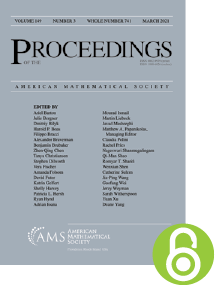Highly-transitive actions of surface groups
HTML articles powered by AMS MathViewer
- by Daniel Kitroser PDF
- Proc. Amer. Math. Soc. 140 (2012), 3365-3375 Request permission
Abstract:
A group action is said to be highly-transitive if it is $k$-transitive for every $k\geq 1$. The main result of this thesis is the following:
Main Theorem. The fundamental group of a closed, orientable surface of genus $> 1$ admits a faithful, highly-transitive action on a countably infinite set.
From a topological point of view, finding a faithful, highly-transitive action of a surface group is equivalent to finding an embedding of the surface group into $\operatorname {sym}{\mathbb {Z}}$ with a dense image. In this topological setting, we use methods that were originally developed for densely embedding surface groups in locally compact groups.
References
- J. Barlev and T. Gelander, Compactifications and algebraic completions of limit groups, J. Anal. Math. 112 (2010), 261–287. MR 2763002, DOI 10.1007/s11854-010-0030-3
- Emmanuel Breuillard, Tsachik Gelander, Juan Souto, and Peter Storm, Dense embeddings of surface groups, Geom. Topol. 10 (2006), 1373–1389. MR 2255501, DOI 10.2140/gt.2006.10.1373
- John D. Dixon, Most finitely generated permutation groups are free, Bull. London Math. Soc. 22 (1990), no. 3, 222–226. MR 1041134, DOI 10.1112/blms/22.3.222
- T. P. McDonough, A permutation representation of a free group, Quart. J. Math. Oxford Ser. (2) 28 (1977), no. 111, 353–356. MR 453869, DOI 10.1093/qmath/28.3.353
Additional Information
- Daniel Kitroser
- Affiliation: Department of Mathematics, Ben-Gurion University of The Negev, Be’er Sheva, Israel
- Email: kitrosar@bgu.ac.il
- Received by editor(s): December 15, 2010
- Received by editor(s) in revised form: April 11, 2011
- Published electronically: April 24, 2012
- Additional Notes: The author was partially supported by ISF grant 888/07
- Communicated by: Daniel Ruberman
- © Copyright 2012 American Mathematical Society
- Journal: Proc. Amer. Math. Soc. 140 (2012), 3365-3375
- MSC (2010): Primary 20B22, 20B35
- DOI: https://doi.org/10.1090/S0002-9939-2012-11195-5
- MathSciNet review: 2929006


